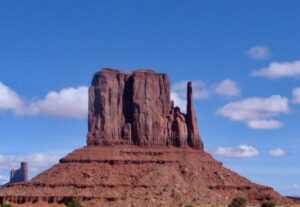 Monument Valley, a deep red-sand red desert area on the Arizona-California border, is recognized for its spectacular mountain-range buttes. The largest of these buttes, the saddleback butte, can cover an area of more than seven thousand acres. The spectacular, western-style saddleback possesses an overall shape that resembles a saddle, with steep banks and deep ravines. The road to the top of the saddleback butte, called the Horse Point Trail, may be used for hiking and biking.
Monument Valley, a deep red-sand red desert area on the Arizona-California border, is recognized for its spectacular mountain-range buttes. The largest of these buttes, the saddleback butte, can cover an area of more than seven thousand acres. The spectacular, western-style saddleback possesses an overall shape that resembles a saddle, with steep banks and deep ravines. The road to the top of the saddleback butte, called the Horse Point Trail, may be used for hiking and biking.
Monument Valley is located in Arizona’s Monument Valley/San Jacinto National Forest. The massive red sandstone canyon is the product of an ancient volcanic chain. The white, hot sandstone butte that tops the saddleback contains dark fissures and exposed corals. Hikers and tourists typically traverse the butte on a trail wheelchair or on an off-road vehicle. The popular, steeply sloping Mittens Buttes can be seen from the road or via overlooks like those of John Ford’s Point.
Monument Valley is known as the Valley of the Sun because of its exposure to the sun for most of the year. The sun evaporates most of the moisture in the soil, leaving behind dry, red sand. Travelers will note that this “red dust” looks almost similar to the “snow.” It has long been a favored destination for travelers because of its naturally beautiful scenery and abundant wildlife. The most obvious feature of the land is the large concentration of ranches and small villages.
The majority of the people living in Monument Valley belong to the Anasazi Indian tribe. These ranchers have made a large commitment to ecological conservation and environmental education. As a result, the majority of their small community live off the land–either eating fishing, or raising cattle. The largest of these communities, Flagstaff, consists of several hundred families.
The biggest ranching operations in Monument Valley belong to the Crowfoot clan. This clan protects and conserves the remaining herds, and has a reservation along the Colorado Navajo border. Many of the towns in Monument Valley were established to provide a variety of employment opportunities. Many of the small ranches contain attractions like trout streams with trout in the river, mountain biking, and hiking trails.
Monument Valley has a warm, dry climate with short mild winters and hot, dry summers. The temperature is relatively steady during the daytime, with cooler temperatures occurring in the evening. It’s warm enough for swimming, fishing, and boating on many of the lakes and rivers. For outdoor enthusiasts, Monument Valley offers hunting and fishing opportunities. The area also has a large amount of land dedicated to cranberries, alfalfa, and sage. This land is used for many things, but is primarily an agricultural production base.
Outdoor enthusiasts can drive for miles through the countryside, passing fields of wheat, alfalfa fields, and rice fields. There are some spectacular views, such as a view of the Wasatch Mountains rising over the valley. During summer, the yellow gold of the bull trout lily and the bright orange of the rainbow trout also adorn the landscape. Many outfitters also offer fly fishing and deep sea fishing trips.
Monument Valley is home to a growing number of visitors who enjoy hiking, mountain biking, camping, hunting, and cabin rentals. Although some people make a living at these activities, most people do not. They come to Monument Valley for the atmosphere, scenery, and wildlife that make it such a special place to visit. Outdoor enthusiasts are able to spend many relaxing days basking under the sun, enjoying the local wildlife, and taking in the scenic beauty that makes Monument Valley such a special place. Monument Valley has something for everyone.